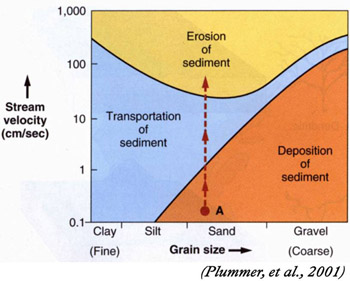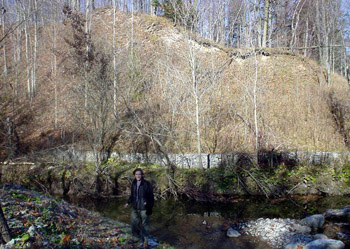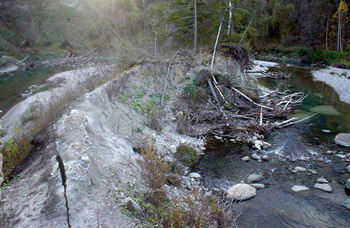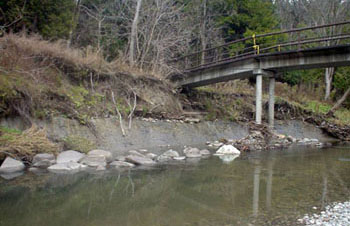Fluvial Erosion
Sediment is often transported down streams and rivers to the Great Lakes. The sediment can
either come from the stream banks, or from sources further inland that do not have adequate
protection from erosion.

Figure 3 | 
Figure 4
|
Streams rarely pick up sediment and transfer them all the way to the mouth of the river without
depositing them on the stream bed, and subsequently being picked up again to be transported.
Shown in figure 3, as grain size decreases, the surface area increases in relation to the mass. This causes
smaller sediments, to be more easily transferred in the river. Larger sediments, move much
shorter distances, and require faster flows of water to move them.
It requires more energy to move and dislodge the larger particles, and they often move shorter distances because of this.
As shown in figure 4 in the diagram, the larger sediments are more apt to be moved along the bottom of the river, while the smaller sediments move higher in the water column, where they can be transferred faster and further.
Very small sediments such as silt, can be dissolved into the water, and be transferred extremely far distances, very often all the way to the mouth of the river, where they enter a lake and eventually settle out.
|

Figure 5 | 
Figure 6
|
Stream rehabilitation work is often focused on creating viable habitat for native fish to breed, feed, and generally survive. Fish often require clear water, with low amounts of sediment being discharged; due to the negative effect that sediment has on their ability to absorb oxygen from the stream. As shown in this picture, work has been done on the edges of the stream to protect it from erosion by the forces of the flowing water. Larger boulders have been placed on the edge that will allow the edges to absorb much of the energy dissipated, as the larger boulders require VERY fast currents to dislodge them. Also at this site, the slopes of the banks of the stream have been reduced and native trees and shrubs are being planted on them to allow their roots to hold onto the sediment. These slopes are also covered in grasses, to additionally hold onto the soil. The slopes often have water flowing down them, which if uncovered, would be essentially unprotected to the erosive force of the water.
This is at the same site, and the previous erosion work can be seen. A large cliff has been exposed of sandy soil that the river had previously eroded. The river edge has been once again been protected by larger boulders, while the cliff itself has had a row of gabion baskets placed at its base to protect the cliff itself, and to disallow any sediments from it from readily entering the stream.
|

Figure 6 : Frenchman's Bay | 
Figure 7 : Duffrin's Creek
|
|
As the flow of water reaches the mouth of the stream or river, it often enters a bay or marsh. This widening of the stream allows for a larger cross-sectional area, and in order for all the water to exit, the velocity of the flow of water is decreased, while the total flow of water remains constant. This slowing down of water, means that the force exerted on the sediment is decreased, and much of the carried sediment settles out, and is deposited.
|
 Figure 8, 9 and 10 - Highland Creek Shore Erosion
Figure 8, 9 and 10 - Highland Creek Shore Erosion
|


|
|
A river, with its powerful erosion mechanism of moving water, can eat away at the edges of the
river and the materials then enter the river, and travel downstream. Pictured here, is the Highland Creek, in Scarborough, Ontario.
|
|

